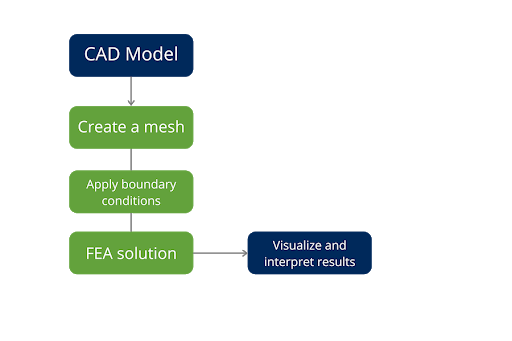An Introduction to Finite Element Analysis
There are several steps in the product development process, from conceptual design all the way to fabrication. One important step early in the process is simulation. Simulation helps engineers understand how their product design will perform in the real world. Simulation can either be done through experimental testing or by using numerical methods, such as finite element analysis.
→ Discover how to conduct expert simulations
What is Finite Element Analysis?
Finite element analysis (FEA) is a numerical method in design simulation for predicting how an object reacts to real-world forces, vibration, and other physical effects. FEA allows you to test individual parts on a computer, visualizing the stresses and adjusting the design to ensure the parts will perform as intended.
Parts and structures are stressed when they are subjected to loads or forces, which leads to strains. These strains are observed as deformation or displacement and can be modeled by governing equations and boundary conditions. Three governing equations, plus boundary conditions such as forces and pressures, form the basis for finite element analysis:
- Equilibrium Equations
- Strain-Displacement Relations
- Constitutive Equations (Hooke’s Law)
→ Start learning FEA now with our introductory course!
Finite element analysis is widely used in the aerospace, automotive, and biomedical industries, but leveraging FEA can be beneficial to all engineering teams by helping lower development costs and leading to a more robust and reliable finished product.

The Basic Steps in the Finite Element Analysis Process
What is the Finite Element Method?
While it might sound like an alternate name for finite element analysis, the finite element method (FEM) is the actual numerical technique used to apply FEA. The finite element method is used to go from partial differential equations (governing equations and boundary conditions) to a set of algebraic equations that can be solved simultaneously by a computer.
Introduction to Finite Element Analysis Course
It’s easy to start learning finite element analysis online with our Introduction to FEA course. These FEA tutorials will give you a conceptual background of FEA and FEA modeling and introduce you to applying the method. You’ll become familiar with SimScale, an easy-to-use online simulation platform, and you can practice alongside two static analysis case studies.
Plus, earn the SolidProfessor Technical Certificate in FEA to show off your skills at the end of the course!
Lessons in this course include:
- Steps in the FEA Process
- FEA Modeling Techniques (Meshing, Boundary Conditions, Material Selection)
- The Finite Element Method (FEM)
- Introduction to SimScale
- Linear and Non-Linear Static Analysis Case Studies
- And more!
You can preview the first five lessons of our Introduction to FEA Course below!
























